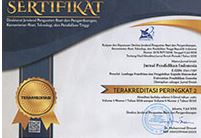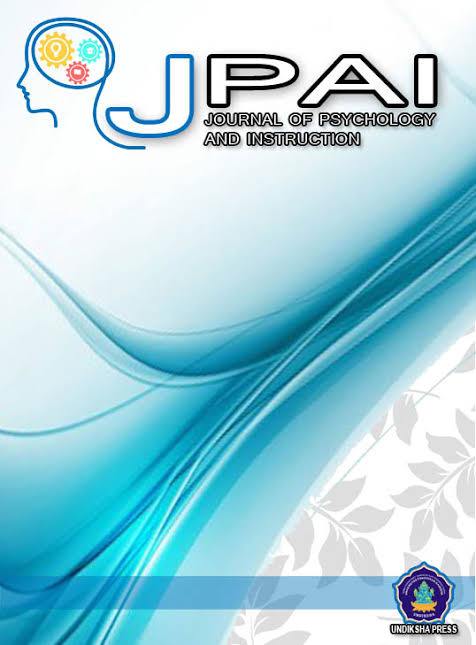Reading-Related Activities in English Textbook for Grade 7th Junior High School and How Teacher Exploited Texts in the Classroom
DOI:
https://doi.org/10.23887/jpai.v6i1.49814Keywords:
Reading-Related Activities, Text Exploitation, Reading ComprehensionAbstract
The use of textbook in the reading class is one of the efforts that can be done by teachers in helping students to improve their abilities, namely by applying reading-related activities contained in the textbooks to the learning process in the classroom. This study aims at analyzing reading-related activities that are available in English textbook entitled “Effective English; Bahasa Inggris untuk SMP/MTs Kelas VII” was used for 7th Grade students and describing how the reading texts were exploited by the English teacher in the classroom. This study employed a qualitative descriptive research design. The subjects of this study were seventh grade students and an English teacher at Junior High School. Data were collected through document analysis, class observations, and interviews. The data in this study were analyzed through the data analysis procedures which include data collection, data reduction, data presentation, and drawing conclusions. The results of this study indicate that there are only a few reading-related activities in the English textbook entitled, namely lexical items and questioning activity. Meanwhile, the teacher’s strategies in exploiting the reading texts were also limited as the teacher closely used reading-related activities available in the textbook. This study was limited in time, number of subjects, and data sources so that further research is suggested for more generalizable findings.
References
Al-Qutaiti, Y. O. (2019). Teaching and learning lexical items. IMPACT: International Journal of Research in Humanities, Arts and Literature, 7(5), 271–276. http://www.impactjournals.us/download/archives/27-05-2019-1558955050.
Anandari, C. L., & Iswandari, Y. A. (2019). Extensive reading in Indonesian schools: a successful story. TEFLIN Journal, 30(2), 137–152. https://doi.org/10.15639/teflinjournal.v30i2/137-152. DOI: https://doi.org/10.15639/teflinjournal.v30i2/137-152
Asmaryadi, I. (2021). Studi Strategi Guru Kelas Dalam Meningkatkan Kemampuan Membaca Permulaan Pada Proses Pembelajaran Daring Kelas Rendah Sdit Cahaya Hati: Teacher Strategy Study In Improving Beginning Reading Ability In The Process Of Learning In The Classroom Low. Jurnal Pendidikan Tematik Dikdas, 6(2), 47–61. https://online-journal.unja.ac.id/JPTD/article/view/12927.
Atiullah, K., Fitriati, W., & Rukmini, D. (2019). English Education Journal Using Revised Bloom’s Taxonomy to Evaluate Higher Order Thinking Skills (Hots) in Reading Comprehension Questions of English Textbook for Year X of High School. English Education Journal, 4(9), 428–436. http://journal.unnes.ac.id/sju/index.php/eej. DOI: https://doi.org/10.15294/eej.v9i4.31794
Ayu, M., & Indrawati, R. (2019). EFL Textbook Evaluation: The Analysis of Tasks Presented in English Textbook. Teknosastik, 16(1), 21. https://doi.org/10.33365/ts.v16i1.87 DOI: https://doi.org/10.33365/ts.v16i1.87
Ayunin, Q., Mirizon, S., & Rosmalina, I. (2013). Pisa Reading Literacy Performance and Its Correlation With Engagement in Reading Activity and Reading Interest. 2000, 573–585. http://conference.unsri.ac.id/index.php/semirata/article/view/1106.
Baig, S., Siddiquah, A., & Javed, F. (2020). An analysis of the competency ‘reading and thinking skills’ in Grade VIII English textbook. Global Social Sciences Review, 5(1), 231–240. https://doi.org/10.31703/gssr.2020(V-I).24. DOI: https://doi.org/10.31703/gssr.2020(V-I).24
Boddaert, G., Cornut, C., & Casalis, S. (2021). Integration of newly learned L2 words into the mental lexicon is modulated by vocabulary learning method. Acta Psychologica, 212, 103220. https://doi.org/10.1016/j.actpsy.2020.103220. DOI: https://doi.org/10.1016/j.actpsy.2020.103220
Charalambous, A. C. (2011). The Role and Use of Course Books in EFL. Online Submission, May.
Damanik, S. N. H., & Zainil, Y. (2019). The analysis of reading comprehension questions in English textbook by using high order thinking skill at grade X of SMAN 2 Padang. Journal of English Language Teaching, 8(1), 249–258. https://doi.org/10.24036/jelt.v8i1.103501.
Dharma, Prasetya, Y., Aristo, T., & Verawanto, J. (2018). An Analysis of English Textbook Relevance to the 2013 English Curriculum. Journal of English Educational Study, 1(1), 24–33. https://doi.org/10.31932/jees.v1i1.277.
Doni, I., Aziz, Z. A., & Fitriani, S. S. (2018). Teaching Reading by Using Cooperative Integrated Reading and Composition. English Education Journal, 9(3), 347–355. http://www.jurnal.unsyiah.ac.id/EEJ/article/view/12216.
Efriana, L. (2021). Problems of online learning during Covid-19 Pandemic in EFL classroom and the solution. JELITA:Journal of English Language Teaching and Literature, 2(1), 38–47. https://jurnal.stkipmb.ac.id/index.php/jelita/article/view/74.
Febrina, F., Usman, B., & Muslem, A. (2019). Analysis of reading comprehension questions by using revised Bloom’s taxonomy on higher order thinking skill (HOTS). English Education Journal, 10(1), 1–15. http://www.e-repository.unsyiah.ac.id/EEJ/article/view/13253.
Giacomazzi, M., Fontana, M., & Camilli Trujillo, C. (2022). Contextualization of critical thinking in sub-Saharan Africa: A systematic integrative review. Thinking Skills and Creativity, 43(October 2020). https://doi.org/10.1016/j.tsc.2021.100978. DOI: https://doi.org/10.1016/j.tsc.2021.100978
Gunantar, D. A. (2017). Textbooks analysis: Analyzing English as a Foreign Language (EFL) textbooks from the perspective of Indonesian culture. Journal of Language and Literature, 11(2), 173–182. https://repository.usm.ac.id/files/journalnas/z171/20180920070237.
Hikmat, M. H. (2017). Developing students’ critical literacy in reading class at an English education department in Indonesia. The 1st International Conference on Language, Literature and Teaching, 474–481. http://hdl.handle.net/11617/9241.
Hoang, L. P., & Arch-Int, N. (2013). Assessment of open-ended questions using a multidimensional approach for the interaction and collaboration of learners in e-learning environments. Journal of Universal Computer Science, 19(7), 932–949. https://www.researchgate.net/profile/Loc-Hoang-Phuoc/publication/286190008.
Issitt, J. (2004). Reflections on the study of textbooks. History of Education, 33(6), 683–696. https://doi.org/10.1080/0046760042000277834. DOI: https://doi.org/10.1080/0046760042000277834
Jang, B. G., & Protacio, M. S. (2020). Use of Cognitive Interviews to Test the Validity of a Reading Motivation Instrument for English Learners. Reading Psychology, 1–21. https://doi.org/https://doi.org/10.1080/02702711.2020.1813226. DOI: https://doi.org/10.1080/02702711.2020.1813226
Louis, R. St., Pereira, S., Berrios, G., & Cartaya, N. (2016). Focus on Reading (9th ed., Issue July).
Margana, M., & Widyantoro, A. (2017). Developing English Textbooks Oriented to Higher Order Thinking Skills for Students of Vocational High Schools in Yogyakarta. Journal of Language Teaching and Research, 8(1), 26. https://doi.org/10.17507/jltr.0801.04. DOI: https://doi.org/10.17507/jltr.0801.04
Miles, M. B., & Huberman, A. M. (1984). Drawing valid meaning from qualitative data: Toward a shared craft. Educational Researcher, 13(5), 20–30. https://doi.org/10.3102/0013189X013005020. DOI: https://doi.org/10.3102/0013189X013005020
Nanda, D. S., & Susanto, S. (2020). Using literary work as authentic material for the EFL classroom in Indonesia. International Journal of Innovation, Creativity and Change, 12(12). https://doi.org/10.31219/osf.io/cjrwt. DOI: https://doi.org/10.31219/osf.io/cjrwt
Napratilora, M., Lisa, H., & Bangsawan, I. (2020). Using WhatsApp as a Learning Media in Teaching Reading. MITRA PGMI: Jurnal Kependidikan MI, 6(2), 116–125. https://doi.org/10.46963/mpgmi.v6i2.129. DOI: https://doi.org/10.46963/mpgmi.v6i2.129
Nassaji, H. (2015). Qualitative and descriptive research: Data type versus data analysis. Language Teaching Research, 19(2), 129–132. https://doi.org/10.1177/1362168815572747. DOI: https://doi.org/10.1177/1362168815572747
Nugrahanto, S., & Zuchdi, D. (2019). Indonesia PISA Result and Impact on The Reading Learning Program in Indonesia. 297(Icille 2018), 373–377. https://doi.org/10.2991/icille-18.2019.77. DOI: https://doi.org/10.2991/icille-18.2019.77
Nurbianta, N., & Dahlia, H. (2018). The Effectiveness of Jigsaw Method in Improving Students Reading Comprehension. ETERNAL (English Teaching Journal), 9(1), 70–86. https://doi.org/10.26877/eternal.v9i1.2416. DOI: https://doi.org/10.26877/eternal.v9i1.2416
Nurdianingsih, F. (2021). Teachers’ strategies in teaching reading comprehension. PROJECT (Professional Journal of English Education), 4(2), 285–289. https://doi.org/10.25157/jall.v4i2.3682. DOI: https://doi.org/10.22460/project.v4i2.p285-289
Nuringtyas, P.L., D., & Purwati, Oikurema. M.A., M. (2015). the Implementation of Extensive Reading Activity To Teach Reading a. Retain, 3(2), 1–8. https://jurnalmahasiswa.unesa.ac.id/index.php/43/article/view/12387.
Paris, T. N. S. T. D., & Yussof, R. L. (2013). Use of ‘time trap board game’to teach grammar. Procedia-Social and Behavioral Sciences, 105, 398–409. https://doi.org/10.1016/j.sbspro.2013.11.042. DOI: https://doi.org/10.1016/j.sbspro.2013.11.042
Sadiku, L. M. (2015). The importance of four skills reading, speaking, writing, listening in a lesson hour. European Journal of Language and Literature, 1(1), 29–31. https://doi.org/10.26417/ejls.v1i1.p29-31. DOI: https://doi.org/10.26417/ejls.v1i1.p29-31
Salikin, H., Bin-Tahir, S. Z., Kusumaningputri, R., & Yuliandari, D. P. (2017). The Indonesian EFL Learners’ Motivation in Reading. English Language Teaching, 10(5), 81. https://doi.org/10.5539/elt.v10n5p81. DOI: https://doi.org/10.5539/elt.v10n5p81
Sangia, R. A. (2018). The Process and Purpose of Reading. Applied Linguistics. DOI: https://doi.org/10.31227/osf.io/2jnf8
Stender, A., Schwichow, M., Zimmerman, C., & Härtig, H. (2018). Making inquiry-based science learning visible: the influence of CVS and cognitive skills on content knowledge learning in guided inquiry. International Journal of Science Education, 40(15), 1812–1831. https://doi.org/10.1080/09500693.2018.1504346. DOI: https://doi.org/10.1080/09500693.2018.1504346
Sucipto, S., & Cahyo, S. D. (2019). A Content Analysis of the Reading Activities in “Bright 2”an English Textbook for Junior High School Students. English Language Teaching Educational Journal, 2(1), 13. https://doi.org/10.12928/eltej.v2i1.918. DOI: https://doi.org/10.12928/eltej.v2i1.918
Surtikanti, M. W., Hertanto, M. A., & Agung, A. S. S. N. (2020). Developing HOTS-Based Critical Reading Textbook for Junior High Schools in Ngabang. Metathesis: Journal of English Language, Literature, and Teaching, 4(2), 205–216. https://doi.org/10.31002/metathesis.v4i2.2784. DOI: https://doi.org/10.31002/metathesis.v4i2.2784
Syaharuddin, S., Perwira Negara, H. R., Ibrahim, M., Mandailina, V., Pramita, D., & Santosa, F. H. (2020). Penelusuran Referensi Berbasis Digital Sebagai Peningkatan Soft Skill Mahasiswa Dalam Menyelesaikan Tugas Akhir. SELAPARANG Jurnal Pengabdian Masyarakat Berkemajuan, 3(2), 151. https://doi.org/10.31764/jpmb.v3i2.1904. DOI: https://doi.org/10.31764/jpmb.v3i2.1904
Syakur, A., Fanani, Z., & Ahmadi, R. (2020). The Effectiveness of Reading English Learning Process Based on Blended Learning through “Absyak” Website Media in Higher Education. Budapest International Research and Critics in Linguistics and Education (BirLE) Journal, 3(2), 763–772. https://doi.org/10.33258/birle.v3i2.927. DOI: https://doi.org/10.33258/birle.v3i2.927
Tayyeh, M. N., Prof, A., Hamza, S., Prof, A., & Aziz, H. (2021). An Analysis Of Reading Comprehension Questions In English Textbook" English For Iraq" According To Revised Bloom’s Taxonomy. Turkish Journal of Computer and Mathematics Education (TURCOMAT), 12(7), 2868–2874. https://doi.org/10.17762/turcomat.v12i7.3880.
Thi, N., & Ngoc, M. (2015). the Essential Roles of Skimming and Scanning Techniques in Teaching Reading Comprehension. 196–198. http://nnkt.ueh.edu.vn/wp-content/uploads/2015/07/20.pdf.
Uddiniyah, N., & Silfia, E. (2019). An analysis of students’ motivation in learning English at SMAN 8 Kota Jambi academic year 2018/2019. Journal Of English Language Teaching, 3(2), 139–149. http://jelt.unbari.ac.id/index.php/jelt/article/view/42.
Yılmaz, M., Atay, D., & Mustafa, E. R. (2020). The effects of extensive reading on turkish learners’ L2 reading/writing performance and foreign language self-concept. Journal of Asia TEFL, 17(1), 53–69. https://doi.org/10.18823/asiatefl.2020.17.1.4.53. DOI: https://doi.org/10.18823/asiatefl.2020.17.1.4.53










